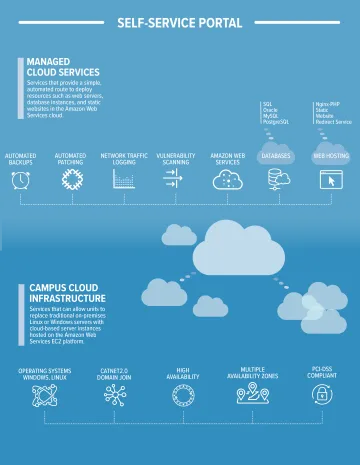Managed Cloud Services
Cost efficiencies gained with less management overhead
Server infrastructure comes with costs—system patching, software licensing, upgrades, hardware environment upkeep and security, and eventual replacement. Cloud infrastructure has its own big learning curve, its own cost model, plus the same system and software issues.
University Information Technology Services (UITS) is taking the guesswork—and much of the cost—out of cloud with Managed Cloud Services (MCS). With pre-configured software environments in Amazon Web Services (AWS), campus units can transition from local servers to cloud environments that are already setup with best practice security, up-to-date operating systems, and licensed, maintained software for numerous SQL database and web hosting solutions. In addition, MCS covers the licensing, storage, and cloud compute costs.
By using AWS cloud hosting, colleges and business units can enjoy significant cost savings on server infrastructure and say goodbye to the hassle of server management. They also align with Arizona’s Cloud First policy, which encourages the adoption of cloud technologies whenever possible. In addition, MCS network security, data encryption, automated patching, backups, and monitoring services strengthen the University’s security measures.
“The big advantage of using MCS is that it comes at no additional cost to colleges and departments,” remarked Mandi Cross, Lead Engineer of Cloud Computing in Infrastructure Services. Many units across campus are already using MCS for their research, such as Biosphere 2.
With Managed Cloud Services, deploying resources like web servers, database instances, and static websites in AWS, hosting in the cloud becomes a breeze. UITS takes care of the deep IT aspects like security, maintenance, and operational stability of the AWS accounts, while faculty and staff retain full control over their data and configurations. This means they can tap into the vast resources of AWS without needing specialized AWS knowledge or direct account access.

UITS also shoulders the responsibility of risk management across the University’s network and server infrastructure, handling automated backups, patching, and scanning for network vulnerabilities, ensuring that departmental data remains secure and systems stay up-to-date.
With the introduction of Managed Cloud Services, UITS aims to make life easier and more efficient. These comprehensive solutions alleviate the burden of managing server infrastructure on your own. Academic and business units will be able to focus on productivity, rather than hardware or cloud management.
Not every IT staff person has the training, time, or both to maintain best-practice configuration and security in Amazon Web Services environments. Jeff Switzer, one of only two IT employees at the National Phenology Network, said, “Wherever we can partition off different responsibilities it helps us focus on the things that we want to do, not the infrastructure problems. Taking some of the security risk responsibility off, too, I can sleep a little better at night.”
Jeff and NPN rely on Managed Cloud Services to host their relational databases, where the software licensing is also covered by the UITS service. For him, “It was a really opportune time because our infrastructure was aging, and we were trying to figure out what to do. We didn’t have a lot of money to purchase new hardware.”
With centrally provided solutions, UITS is helping the University achieve efficiencies of scale, increase security, decrease risk, and free up staff time for truly unit-specific needs.
FY23 Metrics
AMAZON WEB SERVICES
Units Converted
145
ACCESS MANAGEMENT
Access Flow Requests
12.4K
Access Flow Tasks
242.7K
Roles Managed
1402
SERVICE NOW
Service Requests
91.6K
Incidents
67.2K
CONTACT CENTER TELEPHONY
Calls
446K
Units Using
46
Agents
625
